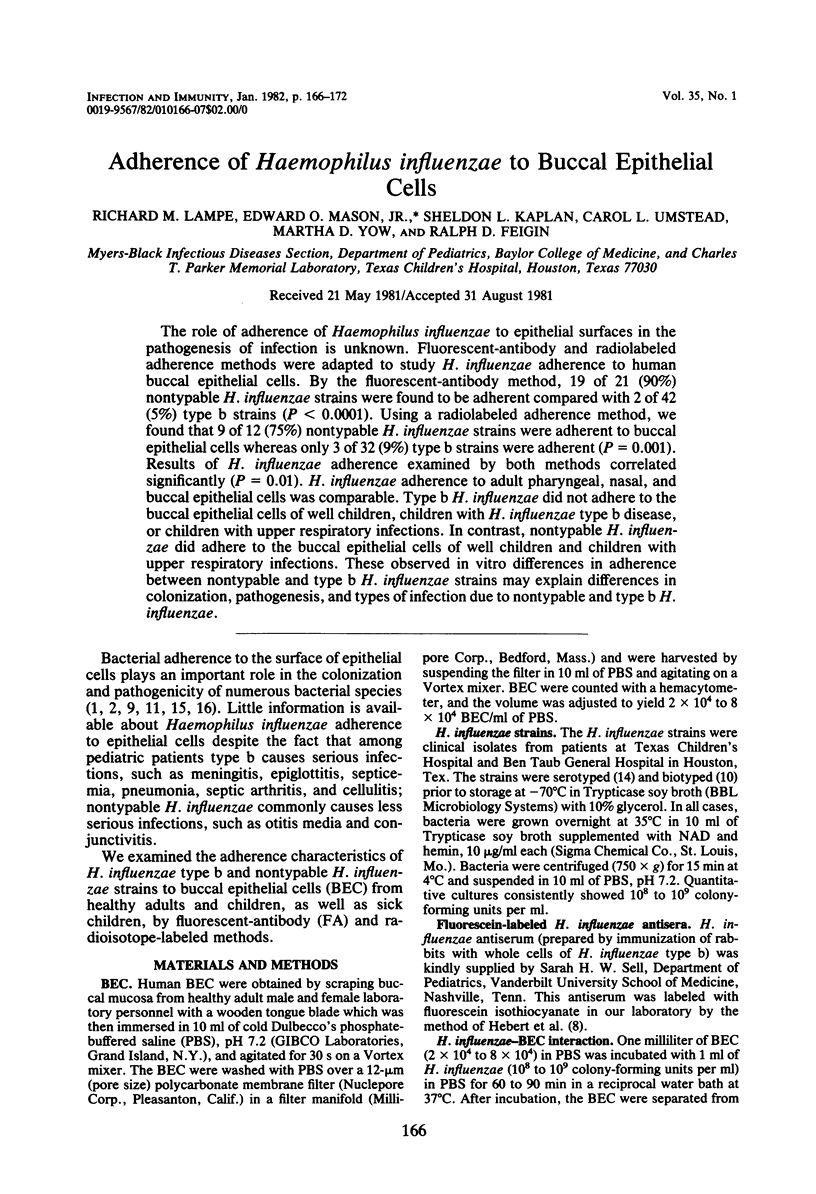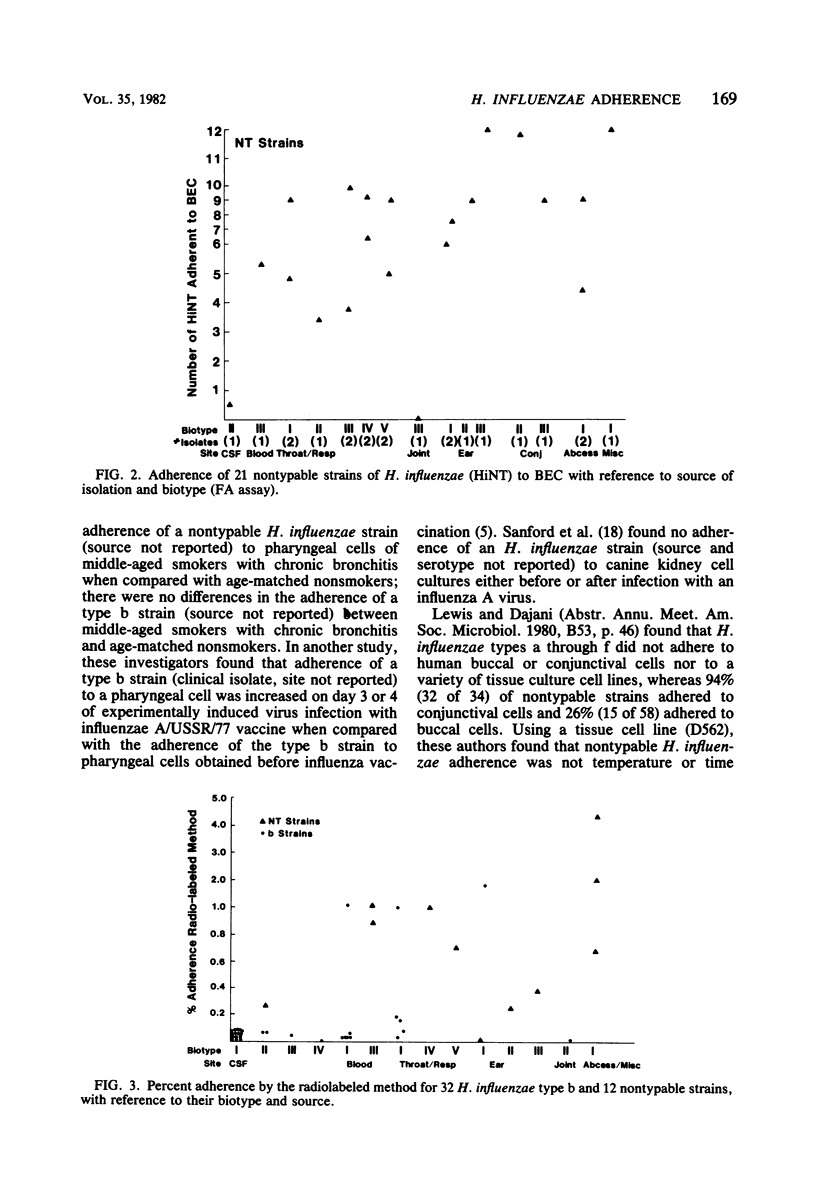Abstract
The role of adherence of Haemophilus influenzae to epithelial surfaces in the pathogenesis of infection is unknown. Fluorescent-antibody and radiolabeled adherence methods were adapted to study H. influenzae adherence to human buccal epithelial cells. By the fluorescent-antibody method, 19 of 21 (90%) nontypable H. influenzae strains were found to be adherent compared with 2 of 42 (5%) type b strains (P less than 0.0001). Using a radiolabeled adherence method, we found that 9 of 12 (75%) nontypable H. influenzae strains were adherent to buccal epithelial cells whereas only 3 of 32 (9%) type b strains were adherent (P = 0.001). Results of H. influenzae adherence examined by both methods correlated significantly (P = 0.01). H. influenzae adherence to adult pharyngeal, nasal, and buccal epithelial cells was comparable. Type b H. influenzae did not adhere to the buccal epithelial cells of well children, children with H. influenzae type b disease, or children with upper respiratory infections. In contrast, nontypable H. influenzae did adhere to the buccal epithelial cells of well children and children with upper respiratory infections. These observed in vitro differences in adherence between nontypable and type b H. influenzae strains may explain differences in colonization, pathogenesis, and types of infection due to nontypable and type b H. influenzae.
Full text
PDF






Selected References
These references are in PubMed. This may not be the complete list of references from this article.
- Aly R., Shinefield H. R., Litz C., Maibach H. I. Role of teichoic acid in the binding of Staphylococcus aureus to nasal epithelial cells. J Infect Dis. 1980 Apr;141(4):463–465. doi: 10.1093/infdis/141.4.463. [DOI] [PubMed] [Google Scholar]
- Andersson B., Eriksson B., Falsen E., Fogh A., Hanson L. A., Nylén O., Peterson H., Svanborg Edén C. Adhesion of Streptococcus pneumoniae to human pharyngeal epithelial cells in vitro: differences in adhesive capacity among strains isolated from subjects with otitis media, septicemia, or meningitis or from healthy carriers. Infect Immun. 1981 Apr;32(1):311–317. doi: 10.1128/iai.32.1.311-317.1981. [DOI] [PMC free article] [PubMed] [Google Scholar]
- Craven D. E., Peppler M. S., Frasch C. E., Mocca L. F., McGrath P. P., Washington G. Adherence of isolates of Neisseria meningitidis from patients and carriers to human buccal epithelial cells. J Infect Dis. 1980 Oct;142(4):556–568. doi: 10.1093/infdis/142.4.556. [DOI] [PubMed] [Google Scholar]
- Fainstein V., Musher D. M. Bacterial adherence to pharyngeal cells in smokers, nonsmokers, and chronic bronchitics. Infect Immun. 1979 Oct;26(1):178–182. doi: 10.1128/iai.26.1.178-182.1979. [DOI] [PMC free article] [PubMed] [Google Scholar]
- Fainstein V., Musher D. M., Cate T. R. Bacterial adherence to pharyngeal cells during viral infection. J Infect Dis. 1980 Feb;141(2):172–176. doi: 10.1093/infdis/141.2.172. [DOI] [PubMed] [Google Scholar]
- Gubish E. R., Jr, Mace M. L., Jr, Steiner S. M., Williams R. P. Assessment of attachment of Neisseria gonorrhoeae to HeLa cells by double radiolabeling. Infect Immun. 1979 Sep;25(3):1043–1050. doi: 10.1128/iai.25.3.1043-1050.1979. [DOI] [PMC free article] [PubMed] [Google Scholar]
- Hall C. B., Douglas R. G., Jr Clinically useful method for the isolation of respiratory syncytial virus. J Infect Dis. 1975 Jan;131(1):1–5. doi: 10.1093/infdis/131.1.1. [DOI] [PubMed] [Google Scholar]
- Johanson W. G., Jr, Woods D. E., Chaudhuri T. Association of respiratory tract colonization with adherence of gram-negative bacilli to epithelial cells. J Infect Dis. 1979 Jun;139(6):667–673. doi: 10.1093/infdis/139.6.667. [DOI] [PubMed] [Google Scholar]
- Kilian M. A taxonomic study of the genus Haemophilus, with the proposal of a new species. J Gen Microbiol. 1976 Mar;93(1):9–62. doi: 10.1099/00221287-93-1-9. [DOI] [PubMed] [Google Scholar]
- King R. D., Lee J. C., Morris A. L. Adherence of Candida albicans and other Candida species to mucosal epithelial cells. Infect Immun. 1980 Feb;27(2):667–674. doi: 10.1128/iai.27.2.667-674.1980. [DOI] [PMC free article] [PubMed] [Google Scholar]
- Myhre E. B. Typing of Haemophilus influenzae by counterimmunoelectrophoresis. Acta Pathol Microbiol Scand B Microbiol Immunol. 1974 Apr;82(2):164–166. doi: 10.1111/j.1699-0463.1974.tb02308.x. [DOI] [PubMed] [Google Scholar]
- Ofek I., Beachey E. H. Bacterial adherence. Adv Intern Med. 1980;25:503–532. [PubMed] [Google Scholar]
- Salit I. E., Morton G. Adherence of Neisseria meningitidis to human epithelial cells. Infect Immun. 1981 Jan;31(1):430–435. doi: 10.1128/iai.31.1.430-435.1981. [DOI] [PMC free article] [PubMed] [Google Scholar]
- Sanford B. A., Shelokov A., Ramsay M. A. Bacterial adherence to virus-infected cells: a cell culture model of bacterial superinfection. J Infect Dis. 1978 Feb;137(2):176–181. doi: 10.1093/infdis/137.2.176. [DOI] [PubMed] [Google Scholar]
- Selinger D. S., Reed W. P. Pneumococcal adherence to human epithelial cells. Infect Immun. 1979 Feb;23(2):545–548. doi: 10.1128/iai.23.2.545-548.1979. [DOI] [PMC free article] [PubMed] [Google Scholar]
- Sugarman B., Donta S. T. Effect of antibiotics on the adherence of enterobacteriaceae to human buccal cells. J Infect Dis. 1979 Oct;140(4):622–625. doi: 10.1093/infdis/140.4.622. [DOI] [PubMed] [Google Scholar]
- Thorne G. M., Deneke C. F., Gorbach S. L. Hemagglutination and adhesiveness of toxigenic Escherichia coli isolated from humans. Infect Immun. 1979 Mar;23(3):690–699. doi: 10.1128/iai.23.3.690-699.1979. [DOI] [PMC free article] [PubMed] [Google Scholar]
- Tramont E. C. Inhibition of adherence of Neisseria gonorrhoeae by human genital secretions. J Clin Invest. 1977 Jan;59(1):117–124. doi: 10.1172/JCI108608. [DOI] [PMC free article] [PubMed] [Google Scholar]


